 W
WThe Rio Branco antbird is a bird species in the family Thamnophilidae. It is found in Brazil (Roraima) and Guyana. Its natural habitats are subtropical or tropical moist lowland forests and subtropical or tropical moist shrubland. It is severely threatened by habitat loss.
 W
WThe saiga antelope, or saiga, is a critically endangered antelope which during antiquity inhabited a vast area of the Eurasian steppe spanning the foothills of the Carpathian Mountains in the northwest and Caucasus in the southwest into Mongolia in the northeast and Dzungaria in the southeast. During the Pleistocene, they also occurred in Beringian North America and the British Isles. Today, the dominant subspecies is only found in one region in Russia and three areas in Kazakhstan. A portion of the Ustiurt population migrates south to Uzbekistan and occasionally Turkmenistan in winter. It is extinct in China and southwestern Mongolia. It was hunted extensively in Romania and Moldova until it became extinct in those regions at the end of the 18th century. The Mongolian subspecies is found only in western Mongolia.
 W
WThe Urrao antpitta, also known as Fenwick's antpitta, is a highly threatened species of bird found in the understory of cloud forest in the Andean highlands of Colombia. The first published description used the scientific name Grallaria fenwickorum ; shortly afterward, a second description using the name Grallaria urraoensis was published. The editors of the latter recognized that the name likely was a junior synonym, but others have questioned the validity of the first description, and various authorities, including the International Ornithological Congress, have adopted G. urraoensis. Antioquia antpitta has been suggested as an English-language name compromise.
 W
WAphanius danfordii, the Kızılırmak toothcarp or Sultan Sazlığı toothcarp, is a species of killifish belonging to the family Cyprinodontidae. It is endemic to the Kızılırmak River and the upper Seyhan River drainage systems and is now restricted to a few locations in the Sultan Sazlığı marshes. Though little data is available, the population of the fish seems to be declining. The International Union for Conservation of Nature has rated its conservation status as being "critically endangered" and fears it may become extinct in the wild if the drainage of the marshes continues.
 W
WAphanius transgrediens, the Acı Göl toothcarp or Acipinar killifish, is a species of freshwater fish in the family Cyprinodontidae. It is endemic to the springs of Lake Acıgöl in Turkey. It is threatened by a reduction in rainfall from climate change, and the abstraction of water from the springs. The introduction of the non-native eastern mosquitofish also threatens this species.
 W
WThe Bavarian pine vole is a vole from the Austrian, Italian, and Bavarian Alps of Europe. It lives in moist meadows at elevations of 600 to 1,000 meters. There are 23 museum specimens of this species. This rodent was previously known to live in only one location, Garmisch-Partenkirchen in Bavaria, which was altered by the construction of a hospital in the 1980s. No specimens of this rodent were recorded after 1962 and it was thought to be extinct. However, a population apparently belonging to this species was discovered in 2000 in Northern Tyrol, just across the German-Austrian border. An Austrian scientist, Friederike Spitzenberger, stumbled upon the species in a live trap. Its species status was confirmed by genetic studies, and it was found to be very closely related to Liechtenstein's vole from the Eastern Alps. Further research is required to determine the size and range of the population and the species has been re-assessed as Critically Endangered by the IUCN.
 W
WBothrops insularis, commonly known as the golden lancehead, is a highly venomous pit viper species endemic to Ilha da Queimada Grande, off the coast of São Paulo state, in Brazil. The species is named for the light yellowish-brown color of its underside and for its head shape that is characteristic of the genus Bothrops. No subspecies of Bothrops insularis are currently recognized. It is one of the most venomous snakes in Latin America.
 W
WThe Montseny brook newt, Calotriton arnoldi, is a species of salamander in the family Salamandridae. It is endemic to the Montseny Massif in northeast Spain. Before it was formally described in 2005, it was mixed with the larger and more widely distributed Pyrenean brook salamander.
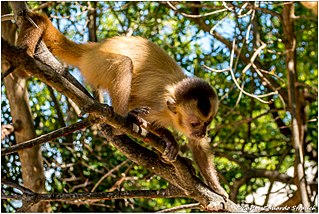 W
WThe Kaapori capuchin is a capuchin monkey endemic to Brazil. This species is located the Brazilian states of Pará and Maranhão along the Atlantic coast to the north of the country, and usually found in dense forest regions, where their food is more abundant, but can also be found in secondary growth areas during the dry season. Like most Capuchins, the Kaapori capuchin is diurnal, arboreal and omnivorous, their diet consisting of small animals and plants. They eat roughly equal portions of plants and animals, mainly feeding on ripe fruits and small insects and invertebrates such as spiders, snails, wasps, caterpillars, grasshoppers, ants, and bird eggs. It weighs about 2 – 3 kg.
 W
WThe Chatham Island pigeon or parea is a bird endemic to the Chatham Islands in New Zealand. Growing to 800g in weight and 55 cm in length, the Chatham Island pigeon is closely related to the kererū or New Zealand pigeon, the only other species in the genus Hemiphaga.
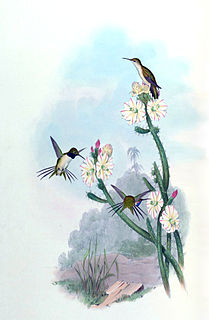 W
WThe Chilean woodstar is a small bird in the hummingbird family, Trochilidae. It is restricted to northernmost Chile with reports from southern Peru. Its natural habitats are dry shrubland and rural gardens. It is threatened by habitat loss and is classed as a critically endangered species. It is usually classified in its own genus Eulidia, but is sometimes placed with the purple-collared woodstar in the genus Myrtis. In 2013, it was classed as endangered, but recently, it was classed as critically endangered by the IUCN Red List.
 W
WThe royal cinclodes is a passerine bird which breeds in the Andes of south-east Peru and adjacent Bolivia. It was formerly considered to be a subspecies of the stout-billed cinclodes C. excelsior. It is 20 cm long and weighs 50 g with a heavy bill and dark chocolate-brown on the body, face and crown with whitish mottling and streaking on the breast.
 W
WThe European eel is a species of eel, a snake-like, catadromous fish. They are normally around 60–80 cm (2.0–2.6 ft) and rarely reach more than 1 m, but can reach a length of up to 1.5 m in exceptional cases.
 W
WThe European mink, also known as the Russian mink and Eurasian mink, is a semiaquatic species of mustelid native to Europe.
 W
WThe Juan Fernández firecrown is a hummingbird found today solely on Isla Róbinson Crusoe, one of a three-island archipelago belonging to Chile. It is non-migratory and shares the island with its smaller relative the green-backed firecrown.
 W
WThe hooded grebe, is a medium-sized grebe found in the southern region of Argentina. It grows to about 32 cm (13 in) in length, and is black and white in color. It is found in isolated lakes in the most remote parts of Patagonia and spends winters along the coast of the same region. In 2012 IUCN uplisted the species from Endangered to Critically Endangered.
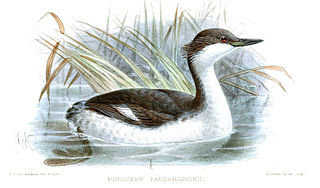 W
WThe Junín grebe, also known as Junin flightless grebe or puna grebe, is a grebe found only on Lake Junin in the highlands of Junín, west-central Peru. The grebe generally breeds in bays and channels around the edge of the Lake, within 8–75 m (26–246 ft) of reed beds, entering the reeds only for nesting or roosting. When not breeding, Junin grebe prefer open water, moving far out from lake shores. The current population is estimated at less than 250.
 W
WThe blue-bearded helmetcrest is a species of hummingbird endemic to the Santa Marta Mountains in northeastern Colombia. It has elongated purply blue throated feathers, which assemble in the form of a beard and a prominent white crest. The white frame from the face extends from the rear of the head, around the ear coverts and down to the breast side
 W
WThe Highland splitfin is a species of splitfin endemic to Mexico where it is found in the Lerma River basin. This species grows to a length of 5 centimetres (2.0 in) TL. It is the only known member of its genus, although some authorities have Hubbina as a subgenus of Girardinichthys and add Girardinichthys ireneae to the subgenus, even treating this taxon as a synonym of G. ireneae. This species was described by Don Fernando de Buen y Lozano in 1940 with the type locality given as Cointzio, Michoacán. The name of the genus honours the American ichthyologist Carl Leavitt Hubbs (1894-1979) while the specific name honours Clarence Lester Turner (1890-1969), thus honouring two ichthyologists who worked on a review of the Goodeidae in 1939.
 W
WThe Javan leopard is a leopard subspecies confined to the Indonesian island of Java. It has been listed as Critically Endangered on the IUCN Red List since 2008. The population is estimated at less than 250 mature individuals, with a decreasing population trend. The total remaining habitat is estimated at only 2,267.9 to 3,277.3 km2.
 W
WEvery known living kākāpō, except some young chicks, has been given a name by Kākāpō Recovery Programme officials. Many of the older birds were given English language names, but more recent chicks have been given Māori names. Some kākāpō, such as Richard Henry and Moorhouse, are named after people who have provided assistance to the preservation efforts. A kākāpō interactive family tree is available.
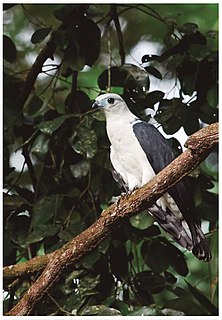 W
WThe white-collared kite is a South American raptor. It is endemic to northeastern Brazil.
 W
WLagidium ahuacaense is a rodent in the mountain viscacha genus (Lagidium) that occurs in southern Ecuador. First observed in 2005 and formally described in 2009, it occurs more than 500 km (310 mi) north of the nearest previously known population of mountain viscachas in central Peru. Only a single population is known, found on rocky habitats on Cerro El Ahuaca, an isolated granite mountain in southern Ecuador, and as few as several dozen individuals remain. The species is threatened by fires and grazing cattle, and the discoverers recommended its conservation status be assessed as critically endangered.
 W
WPeracchi's nectar bat is a species of nectar-feeding bat in the family Phyllostomidae. It was first described from the Atlantic Forest in southeastern Brazil.
 W
WSpix's macaw, also known as the little blue macaw, was a macaw native to Brazil. It is a member of tribe Arini in the subfamily Arinae, part of the family Psittacidae. It was first described by German naturalist Georg Marcgrave, when he was working in the State of Pernambuco, Brazil in 1638 and it is named for German naturalist Johann Baptist von Spix, who collected a specimen in 1819 on the bank of the Rio São Francisco in northeast Bahia in Brazil.
 W
WThe Magdalena River turtle, or Rio Magdalena river turtle, is a species of turtle in the family Podocnemididae. Its phylogeny can be traced back to the Cretaceous Period, where the species shared its last evolutionary ancestor 100 million years ago. It is endemic to northern Colombia, where its home range consists of the Sinú, San Jorge, Cauca, and Magdalena river basins.
 W
WThe Araripe manakin is a species of critically endangered bird from the family of manakins (Pipridae). It was discovered in 1996 and scientifically described in 1998. The species epithet commemorates Brazilian zoologist and wildlife filmmaker Werner Bokermann, who died in 1995. Because of its helmet-like crown it has received the Portuguese name soldadinho-do-araripe which means "little soldier of Araripe". This name also associates it with the related, but more widespread, helmeted manakin, which is known simply as the soldadinho.
 W
WThe mangrove finch is a species of bird in the Darwin's finch group of the tanager family Thraupidae. It is endemic to the Galápagos Islands. It was found on the islands of Fernandina and Isabela, but recent surveys have failed to record the species on Fernandina. It has been classified as critically endangered by BirdLife International, with an estimated population of between 60 and 140 located in two large mangroves on Isabela. A study has shown that the two small populations remaining on Isabela Island have begun undergoing speciation and that one or both populations will eventually become extinct due to a lack of interbreeding.
 W
WThe white-eyed river martin is a passerine bird, one of only two members of the river martin subfamily of the swallows. Since it has significant differences from its closest relative, the African river martin, it is sometimes placed in its own genus, Eurochelidon. First found in 1968, it is known only from a single wintering site in Thailand, and may be extinct, since it has not been seen since 1980 despite targeted surveys in Thailand and neighbouring Cambodia. It may possibly still breed in China or Southeast Asia, but a Chinese painting initially thought to depict this species was later reassessed as showing pratincoles.
 W
WThe Brazilian merganser is a South American diving duck in the Mergus genus. It is one of the six most threatened waterfowl in the world, with possibly fewer than 250 birds in the wild and a few kept in captivity in Brazil. The origin of its name is from its long, sharp-edged beak that has a great number of teeth-looking edges.
 W
WThe Floreana mockingbird or the Charles Island mockingbird, is a species of bird in the family Mimidae.
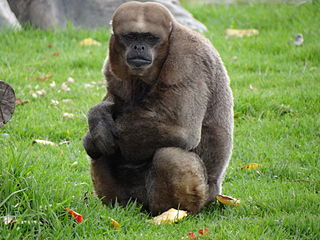 W
WThe Colombian woolly monkey is a critically endangered species of woolly monkey from Colombia and possibly also Venezuela. Among all atelinae primates, Colombian woolly monkeys exhibit the most sexual dimorphism in body size. Males are about forty-five percent heavier than their female counterparts. However, the cause of this dimorphism remains an enigma as there are no apparent female choice in favor of larger males. In fact, mating amongst Colombian woolly monkeys is promiscuous in that all adult and subadult males in a group mate with each female in estrous, and male-male rivalries in the context of mating are very rare.
 W
WThe Montseny brook newt, Calotriton arnoldi, is a species of salamander in the family Salamandridae. It is endemic to the Montseny Massif in northeast Spain. Before it was formally described in 2005, it was mixed with the larger and more widely distributed Pyrenean brook salamander.
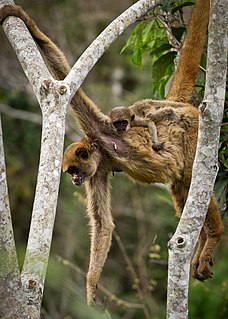 W
WThe northern muriqui is an endangered muriqui or woolly spider monkey species endemic to Brazil. It is unusual among primates in that it shows egaliterian social relationships. It is found in the Atlantic Forest region of the Brazilian states of Rio de Janeiro, Espírito Santo, Minas Gerais and Bahia. Muriquis are the largest species of New World monkeys. The northern muriqui can grow up to 4.3 ft long. It feeds mainly on leaves and twigs, but will also eat fruit. It often hangs upside-down by its prehensile tail while eating.
 W
WThe northern brown howler is the type subspecies of the brown howler, native to Brazil. It is listed as critically endangered, with fewer than 250 individuals restricted to vicinity of the Jequitinhonha River. The species feeds on fruits, flowers, and by preference immature leaves which are easier to digest than mature leaves; foraging for these foods in hillside habitats was shown to require more energy expenditure than in valley habitats.
 W
WThe one-striped opossum is a possibly extinct opossum species from South America. It is known only from two specimens found in Brazil in 1821 and Argentina in 1899.
 W
WPangolins, sometimes known as scaly anteaters, are mammals of the order Pholidota. The one extant family, Manidae, has three genera: Manis, Phataginus and Smutsia. Manis comprises the four species found in Asia, while Phataginus and Smutsia include two species each, all found in sub-Saharan Africa. These species range in size from 30 to 100 cm. A number of extinct pangolin species are also known.
 W
WParoedura lohatsara is a species of small-to-medium-sized geckos native to northern Madagascar where it is found on a single mountain range. These geckos are up to 6 cm (2.4 in) long and are brown with black speckling, the speckles sometimes combining into longitudinal bands. Juveniles have wide transverse bands of black and transition into the adult colouring as they grow. This gecko is mainly nocturnal and is found on the ground, on boulders and in the lowest branches of trees. Because of its limited range and the ongoing destruction of its forest habitat, this species is listed as critically endangered on the IUCN Red List. It is not currently protected under CITES. Some individuals are kept in captivity in the United States and may act as a genetic resource if the gecko becomes extinct in the wild.
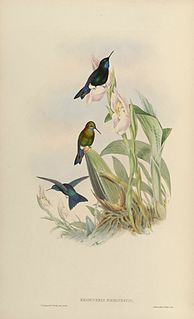 W
WThe black-breasted puffleg is a species of hummingbird native to Ecuador. It is critically endangered, with less than 300 individuals remaining in the wild.
 W
WThe colorful puffleg is an endangered hummingbird endemic to Colombia.
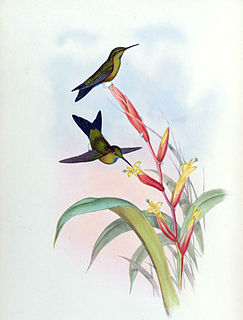 W
WThe turquoise-throated puffleg, also known as Godin's puffleg, is a species of hummingbird from Ecuador. It is mostly green with blue undertail coverts and white powder-puffs of downy feathers on the legs, and the male has a bluish-purple throat patch. It is only known from a few specimens taken in the nineteenth century and its taxonomic position is unclear. The type of habitat in which the type species was recovered has largely disappeared, and recent surveys trying to find this bird have failed. The International Union for Conservation of Nature believes it may be extinct, but there is a possibility that some individuals remain, so the bird has been rated as "critically endangered".
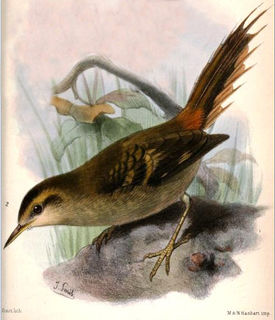 W
WThe Masafuera rayadito is a rare bird endemic to Alejandro Selkirk Island in the Juan Fernández Islands. The species is a member of the ovenbird family and only one of two species in the rayadito genus. The species' natural habitat is humid montane scrub, dominated by tree ferns and ferns between 800–1300 m above sea level.
 W
WThe San Felipe hutia, also known as the little earth hutia, formerly found in Cuba, is listed on the 2008 IUCN Red List as Critically Endangered, possibly extinct.
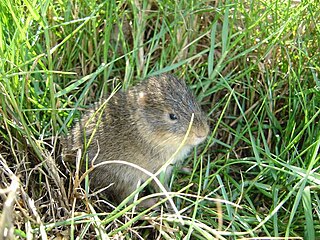 W
WSanta Catarina's guinea pig or Moleques do Sul cavy is a rare guinea pig species of southeastern South America.
 W
WThe cotton-top tamarin is a small New World monkey weighing less than 0.5 kg (1.1 lb). This New World monkey can live up to 24 years, but most of them die by 13 years. One of the smallest primates, the cotton-top tamarin is easily recognized by the long, white sagittal crest extending from its forehead to its shoulders. The species is found in tropical forest edges and secondary forests in northwestern Colombia, where it is arboreal and diurnal. Its diet includes insects and plant exudates, and it is an important seed disperser in the tropical ecosystem.
 W
WThe black-faced lion tamarin or Superagüi lion tamarin is a small New World monkey of the family Callitrichidae. It is critically endangered and endemic to coastal forests in southeastern Brazil. There are several conservation projects and the total populations is unlikely to exceed 400 individuals. It is overall golden-orange with contrasting black head, legs and tail.
 W
WThe cherry-throated tanager is a medium-sized passerine bird. This critically endangered tanager is an endemic to handful of localities in the Atlantic Forest in Espírito Santo, Brazil, though the possibility that it occurs in adjacent parts of Minas Gerais and Rio de Janeiro cannot be discounted. It has a striking, essentially black-white-red plumage; a photo is online in the abstract of Bauer et al. 1998.
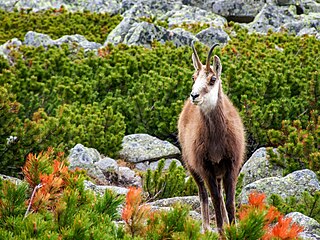 W
WThe Tatra chamois is a subspecies of the chamois of the genus Rupicapra. Tatra chamois live in the Tatra Mountains in Slovakia and Poland.
 W
WThe Caquetá titi, Plecturocebus caquetensis, also known as the red-bearded titi or the bushy-bearded titi, is a species of titi monkey endemic to Colombia found in the Department of Caquetá region. Taxonomically, it is a member of the "Callicebus cupreus group", following Shunsuke Kobayashi's Callicebus grouping. It was first described by Thomas Defler, Marta Bueno and Javier Garcia in 2010. It is highly endangered due to habitat fragmentation and a small population.
 W
WThe Rio Mayo titi is a species of titi, a type of New World monkey, endemic to Peru. The Rio Mayo titi, was thought previously to have a small range of origin in the Alto Mayo valley, but research has proven that the range extends southward and reaches the Huayamba River, as well as Bajo Mayo. It had been classified as vulnerable but due to major habitat loss and restricted living space, it is now classified as Critically Endangered. In October 2012, it was included in The World's 25 Most Endangered Primates list. An increase in deforestation is leading to the decrease in available living space for this titi monkey, forcing it to live in sympatry with another species of Callicebus. Yet in some areas, such drastic deforestation has resulted in extremely high population density. The Rio Mayo titi is better adapted to moderately populated areas, thus overpopulation negatively impacts the species. The forests the Rio Mayo titi lives in are being destroyed for agricultural purposes, leaving little forest for the monkeys. They were only seen a few times and featured in museums until 2003 when more research was done on them. In order for this species to survive, their forests need to be protected to avoid overpopulation. Different conservation groups are working to help P. oenanthe survive. Neotropical Primate Conservation, Proyecto Mono Tocón and Amazónicos para la Amazonia are working in the more southern areas to protect the monkey. The Rio Mayo titi is a fairly inconspicuous creature, making observation and research difficult to obtain. Therefore, the traditional use of transect observation to monitor the monkey's population, is less effective. Instead, other methods of calculating the titi monkey's density in certain areas have been taken, such as research into the species-specific calls endemic to a certain area.
 W
WThe hawksbill sea turtle is a critically endangered sea turtle belonging to the family Cheloniidae. It is the only extant species in the genus Eretmochelys. The species has a worldwide distribution, with Atlantic and Indo-Pacific subspecies—E. i. imbricata and E. i. bissa, respectively.
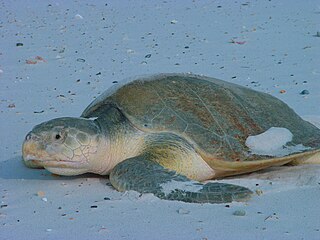 W
WKemp's ridley sea turtle, also called the Atlantic ridley sea turtle, is the rarest species of sea turtle and is critically endangered. It is one of two living species in the genus Lepidochelys.
 W
WTyphlocaris galilea is a species of troglobitic shrimp in the genus Typhlocaris, and is endemic to one pool and spring that feeds it, at Tabgha in Israel. The species is critically endangered and a conservation programme has begun.
 W
WThe wild Bactrian camel is a critically endangered species of camel living in parts of northern China and southern Mongolia. It is closely related to the Bactrian camel. Both are large, double-humped even-toed ungulates native to the steppes of central Asia. Until recently, wild Bactrian camels were thought to have descended from domesticated Bactrian camels that became feral after being released into the wild. However, genetic studies have established it as a separate species which diverged from the Bactrian camel about 1.1 million years ago.
 W
WThe Munchique wood wren is a member of the wren family (Troglodytidae), described as new to science in 2003. It was first observed by Steven Hilty in the 1980s and not described until detailed studies by Paul Salaman, Paul Coopmans, Thomas Donegan and others in the region in 2001. The Munchique wood wren is replaced sharply by the grey-breasted wood wren at lower elevations and on an opposite Andean mountain slope.